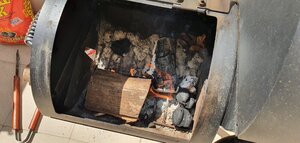You are on the correct learning path my friend.
First thing you will need to do is really learn your system doing more controlled smokes. Don't worry about 225F-250F to much higher temp smokes. The key is that the food get's cooked properly and gets the correct type of smoke (Thin Blue Smoke [TBS] not thick white) and the correct amount of smoke (you can under smoke or over smoke).
To answer your questions I check beef brisket for tenderness at 200F Internal Temp (IT). If I'm doing a USDA Prime grade brisket I check at 198F IT. If not tender I check every 2F degree increase. You won't overdue it this way as long as your thermometer alarm goes off when you hit the 2F limit.
IMPORTANT: There is a major issue people do not understand or just don't know about when it comes to the IT of a brisket. The issue is that getting correct probe placement to get accurate IT of a brisket is DIFFICULT to accomplish. This is why people report such wildly different temps of when their brisket is tender and therefore done!
MAGIC SPOT: The spot to aim for on a whole packer brisket or one cut like you had is the thickest yet center-most spot of the FLAT muscle. The Point muscle will always come up to temp faster and will be tender and better, the FLAT muscle is the problem child.
Here is a picture of where I put 5 probes into a brisket aiming for the proper spot and you see how different they can be.
View attachment 496381
Beef brisket is a hard one to start learning with and it is likely you don't have access to Pork Butt/Shoulder cuts of meat where you are at in the world so I'm not sure what you have access too that is cheaper to practice with. Maybe mutton or lamb.
What I'm getting at is that if you can practice your big long smokes on a less expensive cut of meat you can dial in your smoker and your process then come back to briskets.
Once you have your smoker/system figured out for long smokes you can then do most long smokes with confidence.
Same thing applies for shorter smokes.
THEN, you can start working on how to tailor your cooks/smokes for each different cut of meat as they always have different quirks or tweaks you have to make based on the meat NOT based on your smoker.
For example. Any poultry (chicken) with skin on you should know that the skin will be like leather unless you cook/smoke at 325F or higher. Also whole birds and white meat should really be brined.
Dark meat doesn't need to be brined and get seasoned and thrown right on.
HOWEVER, skinless poultry can be smoked at any temp BUT white meat brining still applies. At least with skinless you can smoke at lower smoker temps to get more time in the smoke.
So, you see doing chicken has different processes inside different process which are different from doing brisket.
So this is why I always recommend that new smokers 1st work on controlling their smoker heat and smoke out put. Do shorter 3-6 hour smokes at 325F. Also do them at 225-250F but don't fret if you can't stay that low because in the end it's just heat and smoke that matters not necessarily a specific temp (unless doing bacon or sausage haha).
Move on to longer smokers for things like briskets.
Finally start learning the processes each different meat wants/needs.
I hope all this info helps :)








